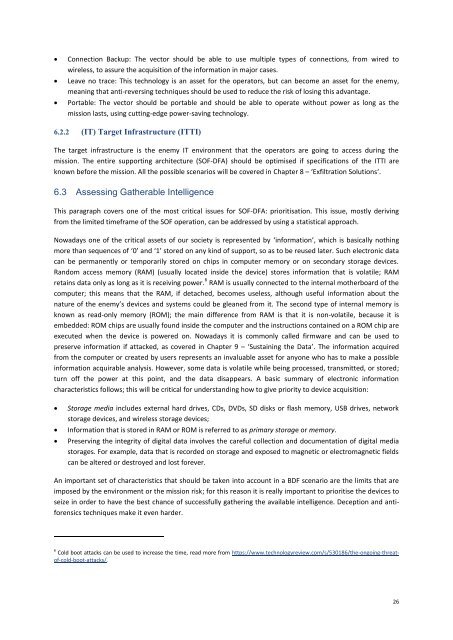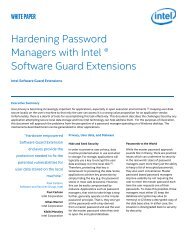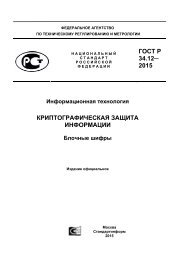BATTLEFIELD DIGITAL FORENSICS
BDF_Battlefield_Digital_Forensics_final
BDF_Battlefield_Digital_Forensics_final
You also want an ePaper? Increase the reach of your titles
YUMPU automatically turns print PDFs into web optimized ePapers that Google loves.
Connection Backup: The vector should be able to use multiple types of connections, from wired to<br />
wireless, to assure the acquisition of the information in major cases.<br />
Leave no trace: This technology is an asset for the operators, but can become an asset for the enemy,<br />
meaning that anti-reversing techniques should be used to reduce the risk of losing this advantage.<br />
Portable: The vector should be portable and should be able to operate without power as long as the<br />
mission lasts, using cutting-edge power-saving technology.<br />
6.2.2 (IT) Target Infrastructure (ITTI)<br />
The target infrastructure is the enemy IT environment that the operators are going to access during the<br />
mission. The entire supporting architecture (SOF-DFA) should be optimised if specifications of the ITTI are<br />
known before the mission. All the possible scenarios will be covered in Chapter 8 – ‘Exfiltration Solutions‘.<br />
6.3 Assessing Gatherable Intelligence<br />
This paragraph covers one of the most critical issues for SOF-DFA: prioritisation. This issue, mostly deriving<br />
from the limited timeframe of the SOF operation, can be addressed by using a statistical approach.<br />
Nowadays one of the critical assets of our society is represented by ‘information’, which is basically nothing<br />
more than sequences of ‘0’ and ‘1’ stored on any kind of support, so as to be reused later. Such electronic data<br />
can be permanently or temporarily stored on chips in computer memory or on secondary storage devices.<br />
Random access memory (RAM) (usually located inside the device) stores information that is volatile; RAM<br />
retains data only as long as it is receiving power. 6 RAM is usually connected to the internal motherboard of the<br />
computer; this means that the RAM, if detached, becomes useless, although useful information about the<br />
nature of the enemy’s devices and systems could be gleaned from it. The second type of internal memory is<br />
known as read-only memory (ROM); the main difference from RAM is that it is non-volatile, because it is<br />
embedded: ROM chips are usually found inside the computer and the instructions contained on a ROM chip are<br />
executed when the device is powered on. Nowadays it is commonly called firmware and can be used to<br />
preserve information if attacked, as covered in Chapter 9 – ‘Sustaining the Data’. The information acquired<br />
from the computer or created by users represents an invaluable asset for anyone who has to make a possible<br />
information acquirable analysis. However, some data is volatile while being processed, transmitted, or stored;<br />
turn off the power at this point, and the data disappears. A basic summary of electronic information<br />
characteristics follows; this will be critical for understanding how to give priority to device acquisition:<br />
<br />
<br />
<br />
Storage media includes external hard drives, CDs, DVDs, SD disks or flash memory, USB drives, network<br />
storage devices, and wireless storage devices;<br />
Information that is stored in RAM or ROM is referred to as primary storage or memory.<br />
Preserving the integrity of digital data involves the careful collection and documentation of digital media<br />
storages. For example, data that is recorded on storage and exposed to magnetic or electromagnetic fields<br />
can be altered or destroyed and lost forever.<br />
An important set of characteristics that should be taken into account in a BDF scenario are the limits that are<br />
imposed by the environment or the mission risk; for this reason it is really important to prioritise the devices to<br />
seize in order to have the best chance of successfully gathering the available intelligence. Deception and antiforensics<br />
techniques make it even harder.<br />
6 Cold boot attacks can be used to increase the time, read more from https://www.technologyreview.com/s/530186/the-ongoing-threatof-cold-boot-attacks/.<br />
26





